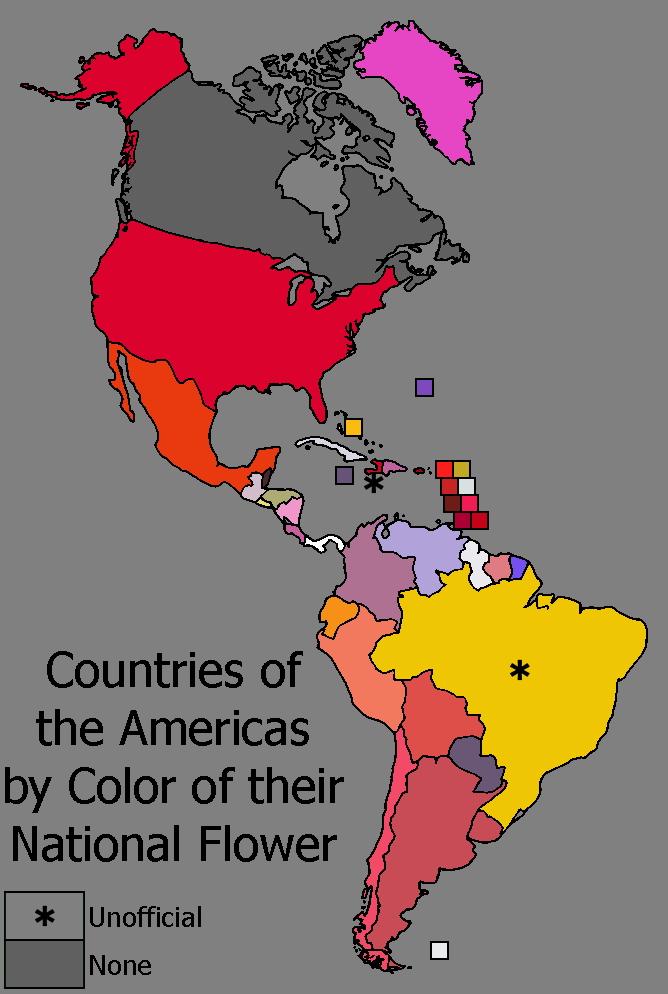National Flower Colors Map of the Americas


Marcus Rodriguez
Historical Geography Expert
Marcus Rodriguez specializes in historical cartography and geographic data analysis. With a background in both history and geography, he brings unique...
Geographic Analysis
What This Map Shows
The "Countries of the Americas by Color of their National Flower" map is a vibrant and playful visualization that displays the national flowers of various countries across North, Central, and South America, categorized by their colors. It’s a fascinating look at how diverse and colorful the flora of this continent can be, showcasing a spectrum of hues that represent each nation’s unique identity. However, it's important to note that flower colors can be quite variable, leading to some subjectivity in the shades presented here. This map serves as a delightful way to explore the cultural significance of flowers in different countries, even if it’s just for fun!
Deep Dive into National Flowers
National flowers often symbolize a country’s identity, history, and natural beauty. These blossoms can be integral to cultural ceremonies and traditions, reflecting the values and heritage of the people. For instance, the iconic rose, commonly associated with the United States, holds various meanings, from love to freedom, making it a fitting emblem for such a diverse nation. Interestingly, while the rose is often depicted in its classic red hue, it's worth noting that the United States doesn’t have an official flower color, which opens the door for various interpretations.
On the other hand, the national flower of Bolivia is the Kantuta, celebrated for its bright red and yellow colors, which echo the vibrant cultures of its indigenous people. This flower holds significant cultural importance and often features in traditional festivals, further emphasizing the connection between flora and national identity.
Flowers are not just beautiful; they also play essential roles in ecosystems. They attract pollinators such as bees and butterflies, which are crucial for plant reproduction. This interdependence highlights how a country’s national flower can serve as a symbol of ecological health—a reminder of the importance of preserving natural habitats. Ever wondered how different climates affect flower varieties? The diverse climates across the Americas—from the tundra of Canada to the tropical rainforests of Brazil—allow for a rich array of flowers to flourish, each with its own unique adaptations.
The map also features countries like Brazil and Haiti, which have unofficial national flowers widely accepted by their populations. Brazil’s orchid, the Cattleya, is not only a beautiful representation of its biodiversity but also highlights the country's commitment to preserving its natural heritage. The colors of these flowers can evoke feelings of national pride and unity, often becoming part of the national narrative.
Regional Analysis
Looking at the Americas, flower colors vary significantly from region to region, showcasing the rich biodiversity. In the Caribbean, for instance, you’ll see a range of colors reflecting the lush landscapes and vibrant cultures. Countries like Saint Lucia and Barbados have flowers that are not only visually stunning but also play crucial roles in local customs and celebrations. The national flower of Saint Lucia, the Heliconia, is a striking plant that thrives in the island's tropical climate, representing the natural beauty of the region.
In contrast, when examining countries in North America, you’ll notice that while the United States has its rose, Canada opts for the maple leaf as its national symbol—highlighting how different nations choose to represent themselves. Interestingly, Canada’s provinces each have their own flowers, further emphasizing local identities. The western provinces often celebrate native species like the Bunchberry, while the eastern provinces may opt for flowers like the Trillium, showcasing the ecological diversity across the country's vast landscapes.
Moving south, the Andean nations such as Peru and Ecuador have their own unique floral heritage, with flowers like the Cantuta and the Orchid, respectively, symbolizing their cultural richness and biodiversity. These flowers often bloom in vibrant colors, reflecting the colorful tapestry of life in the Andes. It’s fascinating how geography can influence which flowers thrive in particular regions, affecting not only aesthetics but also cultural significance.
Significance and Impact
Understanding the significance of national flowers goes beyond mere aesthetics; it connects to biodiversity, cultural heritage, and ecological health. As countries face challenges like climate change and habitat loss, the preservation of these flowers becomes increasingly vital. They serve as indicators of environmental health and can influence tourism—think of how many visitors flock to see cherry blossoms in Washington, D.C., or the vibrant tulip fields in the Netherlands.
Moreover, flowers often bring communities together, whether through festivals celebrating their beauty or through conservation efforts aimed at protecting their habitats. Trends in gardening and landscape design are also influenced by national flowers, as people seek to connect with their cultural heritage through flora.
In conclusion, the "Countries of the Americas by Color of their National Flower" map is a colorful exploration of national identity, ecology, and cultural pride. It illustrates how flowers can reflect the essence of a nation while highlighting the importance of biodiversity in our changing world. As we continue to cherish and protect these natural treasures, we ensure that future generations will also enjoy the beauty and significance of their national flowers.
Visualization Details
- Published
- August 11, 2025
- Views
- 114
Comments
Loading comments...